
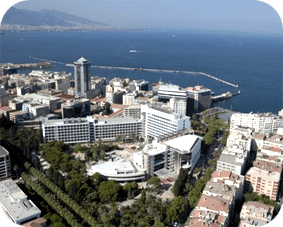
IZMIR
Turkey’s Aegean shores are among the loveliest landscapes in the country. The magnificent coastline, lapped by the clear water of the Aegean Sea, abounds in vast and pristine beaches surrounded by olive groves, rocky crags and pine woods. Dotted with idyllic fishing harbours, popular holiday villages and the remains of ancient civilizations attesting to the inheritance of more than 5,000 years of history, culture and mythology, this region offers a holiday with something for everyone – nature lovers, sun worshippers, photographers, sports enthusiasts, sailors and archaeologists. Along the whole length of the coast, accommodation to suit every taste and price range can be found.
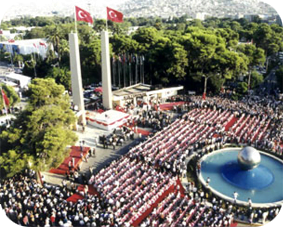
Izmir International Fair
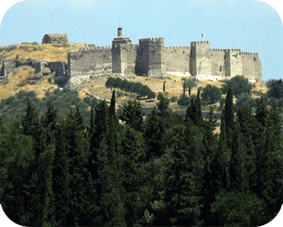
Selcuk
THE BIRTHPLACE OF HOMER
Known in Turkish as “Beautiful Izmir”, the city lies at ‘the head of a long and narrow gulf furrowed by ships and yachts. The climate is mild and in the summer the constant and refreshing sea breezes temper the sun’s heat. Behind the palm-lined promenades and avenues which follow the shoreline, the city, in horizontal terraces, gently ascends the slopes of the surrounding mountains. The third largest city in Turkey, Izmir’s port is second only to Istanbul’s. A cosmopolitan and lively city all year round, during the International Arts Festival June/july) and the International Fair (August/Sept), Izmir bursts with an added vibrancy. The original city was established in the third millennium B.C. (at present day Bayrakli), and at that time shared, with Troy, the most advanced culture in Western Anatolia. By 1500 B.C. it had fallen under the influence of Central Anatolia’s Hittite Empire. In the first millennium B.C. Izmir, then known as Smyrna, ranked as one of the most important cities of the Ionian Federation; during this period – one of the city’s most brilliant – it is believed that Homer resided here. Lydian conquest of the city, around 600 B.C. , brought this period to an end, and Izmir remained little more than a village throughout the Lydian and the subsequent 6th century B.C. Persian rule. In the fourth century B.C. a new city was built at the instigation of Alexander the Great on the slopes of Mt. Pagos (Kadifekale). Izmir’s Roman period, from the first century B.C. , gave birth to its second great era. Byzantine rule followed in the fourth century and lasted until the Selcuk conquest in the 11th century. In 1415, under Sultan Mehmet Celebi, Izmir became part of the Ottoman Empire.
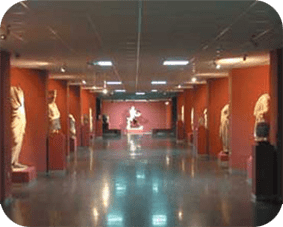
Archeological Museum
MUSEUMS
Archeological Museum, near Konak Square, houses a superb collection antiquities including the statues of Poseidon and Demeter which, in ancient times, stood in the Agora. Neighboring the Archaeology Museum, the collection in the Ethnography Museum contains folkloric artifacts, which includes a fine collection of Bergama and Gordes carpets, traditional costumes and camel bridles. Situated on Ataturk Caddesi, in an old Izmir house used by the founder of the Turkish Republic, the Ataturk Museum exhibits photographs of the leader as well as some of his personal effects. The Fine Arts Museum, located in Konak, displays the works of famous Turkish painters. The Selcuk Yasar Art Museum is a private museum on Cumhuriyet Bulvan with a collection of 20th-century Turkish art. The Natural History Museum and Ege University Botanical Garden in Bornova acts as a natural reserve of the Aegean Region landscapes’ historical preservation. The Odemis Archaeological Museum is about 60 km east of Izmir and displays regional artifacts. The Tire Archaeological Museum is about 50 km east of Izmir. Historical sites and monuments
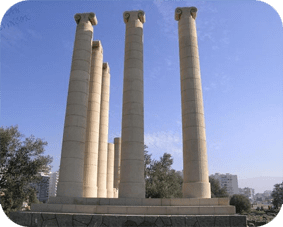
Bayrakli
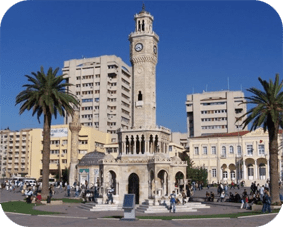
Saat Kulesi (Clock Tower)
HISTORICAL PLACES
The excavations at Bayrakli have unearthed a temple dedicated to Athena, and the wall of the Ionian city which flourished here between the seventh and fifth centuries B.C. Pottery dating to the third millennium B.C. has also been uncovered. On Kadifekale, Mt. Pagos, stands the impressive ruins of a castle and its walls, built by Lysimachus in the reign of Alexander the Great, which still dominate Izmir today The castle offers an excellent vantage point to enjoy the magnificent view over the Gulf of Izmir. The Agora, or marketplace, in the Namazgah Quarter was originally constructed during the rule of Alexander the Great. What remains today, however, dates from the rebuilding under Marcus Aurelius after a devastating earthquake in 178 AD The Sirinyer and Yesildere Aqueducts, two examples of Roman engineering which span the Meles River, supplied Izmir’s water throughout the Byzantine and Ottoman eras. The Saint Polycarp Church remains are of the oldest church in Izmir, and symbolize the Seven Churches of the Apocalypse community Saint Polycarp was martyred at Kadifkale by the Romans in 155 A. D. According to legend, when they tried to burn him, the flames wouldn’t touch him and they finally stabbed him to death. The church was reconstructed in 1620 by Suleyman the Magnificent. An 18th-century Ottoman inn, the Kizlaragasi Han, a fine example of the architecture of the period, is being restored to its former glory. The symbol of Izmir, the Saat Kulesi, or Clock Tower, stands in Konak Square – the heart of the city A gift from the Sultan Abdulhamid, and built in 1901, it is decorated in an elaborate late-Ottoman style. Restored old houses fill the old Asansor quarter, also known as the Jewish quarter. in this quarter, Dario Moreno Sokagi is the main pedestrian street to the Asansor, an elevator from the 19th century which is fifty-one meters in height, and provides access between the lower and upper streets. Situated on the upper side, the Asansor restaurant offers a beautiful view of Izmir. If you find yourself on Havra Sokak in Kemeralti, notice the old buildings and synagogues. In the center of Cumhuriyet Meydani, or Republic Square, stands the Ataturk Monument, an impressive statue of Ataturk sitting on a horse and facing the sea. Erected in 1933, the Monument commemorates the liberation of the city by Turkish Forces. Standing in Karsiyaka, The Flying Dolphins is a Monument that symbolizes friendship and brotherhood.
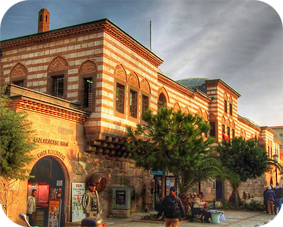
Hisar Mosque
MOSQUES
Hisar Mosque is the largest and oldest in Izmir. Built in the 16th century, with restorations in the 19th-century, it has a delightful interior with an interesting mimber (pulpit) and mihrab (altar). Other mosques in Izmir are Salepcioglu (20th-century), Sadirvan (17th-century with 19th-century restorations) and Kemeralti (17th-century); all are situated close to the Kemeralti Quarter.
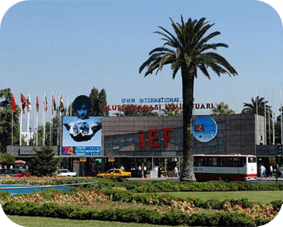
Kulturpark
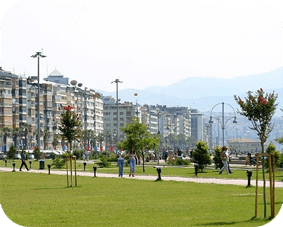
Alsancak (Punta)
PARKS
Kulturpark, the main park of the city, offers many different activities. It’s the site for the International Izmir Fair and contains an amusement park, zoo, restaurant and quiet gardens. Olof Palme Park, situated in Karsiyaka, is a relaxing place to stop. It also offers some sports facilities. Next door, Adnan Saygun Park, a center for artistic activities, contains an ampitheatre for concerts and theatrical productions, and also the Open-Air Museum Park, which has statues scattered throughout the grounds. Insan Haklari (Human Rights) Park has lovely modern statues, including the huge Flying Dolphin Monument. Muammer Aksoy Park is a lovely seaside park with a nice view of Izmir Bay. Turgut Ozal Recreation Park, located in Bayrakli, offers a number of recreational and sporting activities. Art, cultlire and entertainment. Izmir has for many years enjoyed a reputation as a cosmopolitan and cultural city. The Izmir Cultural Center hosts performances of opera, ballet and musical concerts, and the city is home to the Aegean Philharmonic Orchestra as well as a thriving theatrical scene. During the annual Izmir International Festival, international and Turkish artists perform at various venues in the city and surrounding area, including the theatre at Ephesus. Alsancak (Punta), with traditional restored houses, has been converted into a pedestrian entertainment walkway, with bars, cafes and restaurants. Take a horse-drawn carriage along the promenade during the day; afterwards spend the evening absorbing the lively atmosphere of the bars and cafes around Passport Pier.
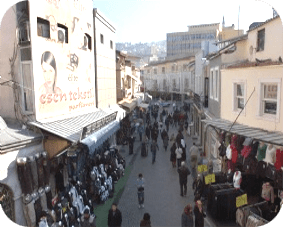
Kemeralti
SHOPPING
In the streets of the Kemeralti Market area, it is possible to find fascinating antiques, both fine and fun jewelery, a great variety of clothing, and the dried figs and sultanas for which Izmir is famous. The fish restaurants in this colorful area serve up local specialities; Tranca and Cipura, two types of sea bream. The best modern and most elegant shops line the Kordon Promenades in Alsancak, Karsiyaka and Cumhuriyet Avenue.
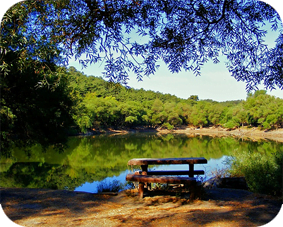
Karagol
IZMIR AND ENVIRONS
Balcova, on the road to Cesme, is one of Turkey’s largest thermal spas, with excellent facilities for guests. Camalti, 15 km west of Karsiyaka, is an area of coastal marshes and salt fields that is preserved as an important bird sanctuary – the Izmir Bird Paradise. Enthusiasts can spot many species, including flamingoes and pelicans. The Yamanlar Camligi, a pine forest near the lovely Karagol Lake 40 km northeast of Karsiyaka, is a popular picnic spot that also provides restaurants and a swimming pool. A Hittite bas-relief is carved into the rock at Kemalpasa (20 km from Izmir) which lies in the Karabel Pass. As the highest point above Izmir, Belkahve overlooks the Gulf of Izmir and is a relaxing spot to enjoy a cup of Turkish coffee. A favorite haunt of Ataturk’s, it is now the site of the largest statue in his honor.
SEVEN CHURCHES
The Seven Churches of the Apocalypse, mentioned by St. John in the Book of Revelation, formed separate and distinct communities, and are all found in Turkey: Izmir (Smyrna), Efes (Ephesus), Eskihisar (Laodicea), Alasehir (Philadelphia), Sart (Sardis), Akhisar (Thyatira), and Bergama (Pergamum). Tours of one to four days can be arranged to see several or all of the churches. Please refer our Seven Churches tours page

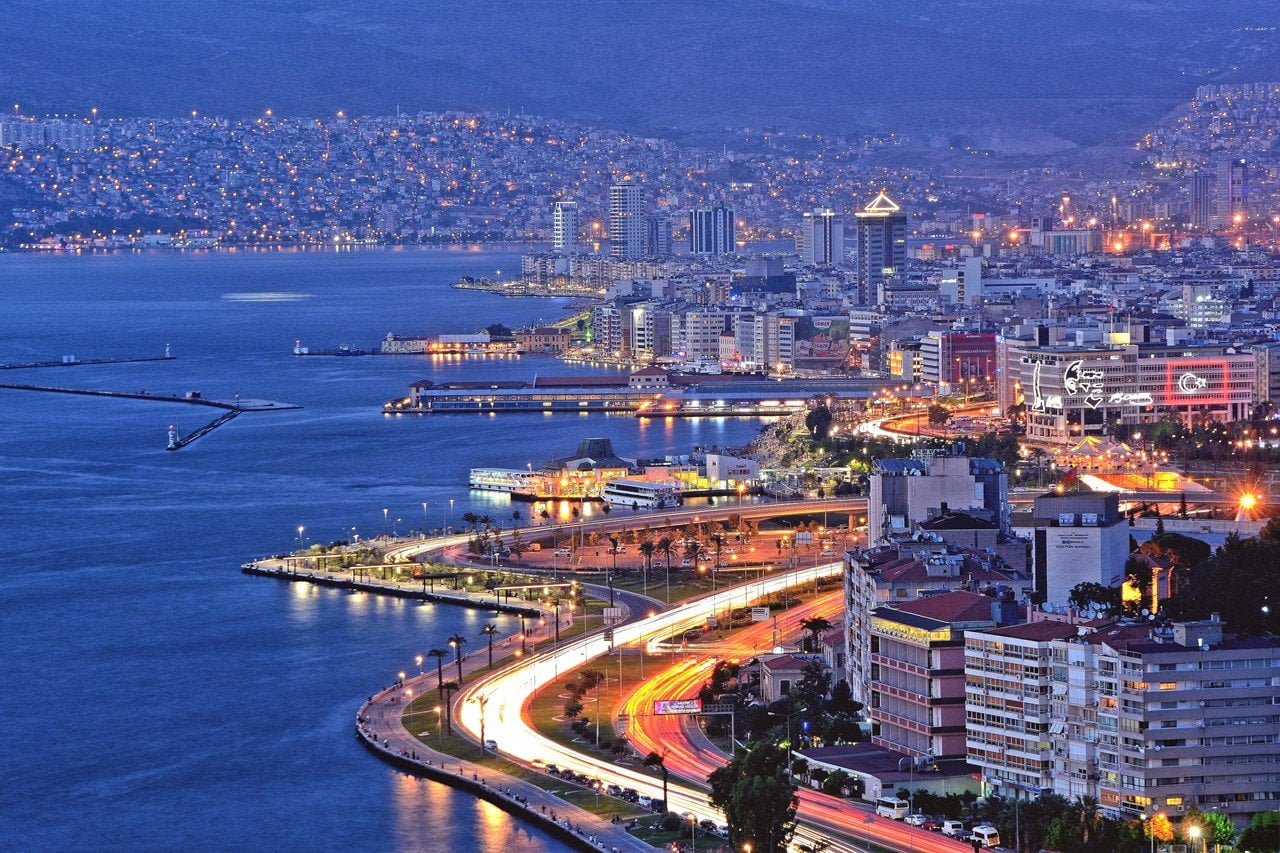
0 Comment